Feasibility of Traditional Open Levee System for River Flood Mitigation in Japan
Abstract
1. Introduction
2. Materials and Methods
2.1. Study Site
2.2. Two-Dimensional River Flood Simulation
2.2.1. Outline
2.2.2. Model Description
2.2.3. Topographic Data
2.2.4. Common Setting
2.2.5. Data Analysis
3. Results
3.1. Model Validation
3.2. Flood Behavior on Floodplain
3.3. Effect of Sub Levees
3.4. Peak Flow Reduction
4. Discussion
4.1. Effect of Open Levee Systems
4.2. Implementation and Management of Open Levees
5. Conclusions
- (1)
- Flooding started at the open part of the levee of Kuji River caused by Typhoon Hagibis in 2019. There used to be another two open parts for the drainage on the downstream side, but were closed by constructing continuous levees. As a result, the floodwater could not return to the river channel, and backwatering led to large-scale inundation.
- (2)
- Comparing the results of the 2D flood simulations for each terrain model representing the status of levee improvement, the inundation area significantly decreased by the continuous levee. However, the intensity of inundation did not necessarily correspond to the improvement of the levees, and the backwatering by the levees caused extremely high inundation depths and a rise in water level, resulting in differences in the risk from place to place. In the studied flood, the open levee was found to reduce the downstream flow load by about 10% at the expense of the inundation of the inland areas. Sub levees, which existed in the past, could work when there were no levees but were less effective when there were continuous levees.
- (3)
- The flood drainage and flood zone limiting functions of open levees will be important under future climate change. It is necessary to treat open levees not as a single facility but as part of a larger system. To achieve this goal, it is critical to shift to a river management approach that considers floods spatially and temporally more, utilizing the latest topographical surveying technology. Adequate indicators for inundation risk and environmental perspective and multi-level floods evaluation ensembles are also needed for better social implementation of open levees.
Author Contributions
Funding
Conflicts of Interest
References
- Sanyal, J.; Lu, X. Application of Remote Sensing in Flood Management with Special Reference to Monsoon Asia: A Review. Nat. Hazards 2004, 33, 283–301. [Google Scholar] [CrossRef]
- Kundzewicz, Z.; Lugeri, N.; Dankers, R.; Hirabayashi, Y.; Döll, P.; Pińskwar, I.; Dysarz, T.; Hochrainer, S.; Matczak, P. Assessing river flood risk and adaptation in Europe—review of projections for the future. Mitig. Adapt. Strateg. Glob. Change 2010, 15, 641–656. [Google Scholar] [CrossRef]
- Trenberth, K. Changes in precipitation with climate change. Clim. Res. 2011, 47, 123–138. [Google Scholar] [CrossRef]
- Dore, M. Climate change and changes in global precipitation patterns: What do we know? Environ. Int. 2005, 31, 1167–1181. [Google Scholar] [CrossRef]
- Kattsov Zhao, Z.; Joussaume, S.; Covey, C.; McAvaney, B.; Ogana, W.; Kitoh, A. Climate change 2001, the scientific basis, chapter 8: Model evaluation. In Contribution of Working Group I to the Third Assessment Report of the Intergovernmental Panel on Climate Change IPCC; Cambridge University Press: Cambridge, UK; New York, NY, USA, 2001; 881p. [Google Scholar]
- Milly, P.; Wetherald, R.; Dunne, K.; Delworth, T. Increasing risk of great floods in a changing climate. Nature 2002, 415, 514–517. [Google Scholar] [CrossRef]
- Hirabayashi, Y.; Mahendran, R.; Koirala, S.; Konoshima, L.; Yamazaki, D.; Watanabe, S.; Kim, H.; Kanae, S. Global flood risk under climate change. Nat. Clim. Change 2013, 3, 816–821. [Google Scholar] [CrossRef]
- Arnell, N.; Gosling, S. The impacts of climate change on river flood risk at the global scale. Clim. Change 2014, 134, 387–401. [Google Scholar] [CrossRef]
- Bouwer, L.; Bubeck, P.; Aerts, J. Changes in future flood risk due to climate and development in a Dutch polder area. Glob. Environ. Change-Hum. Policy Dimens. 2010, 20, 463–471. [Google Scholar] [CrossRef]
- Dinh, Q.; Balica, S.; Popescu, I.; Jonoski, A. Climate change impact on flood hazard, vulnerability and risk of the Long Xuyen Quadrangle in the Mekong Delta. Int. J. River Basin Manag. 2012, 10, 103–120. [Google Scholar] [CrossRef]
- Burby, R.; Deyle, R.; Godschalk, D.; Olshansky, R. Creating Hazard Resilient Communities through Land-Use Planning. Nat. Hazards Rev. 2000, 1, 99–106. [Google Scholar] [CrossRef]
- Smits, A.; Nienhuis, P.; Saeijs, H. Changing Estuaries, Changing Views. Hydrobiologia 2006, 565, 339–355. [Google Scholar] [CrossRef]
- Dobrowolski, J. Human ecology and interdisciplinary cooperation for primary prevention of environmental risk factors for public health. Prz. Lek. 2007, 64 (Suppl. S4), 35–41. [Google Scholar]
- Furuta, N.; Shimatani, Y. Integrating ecological perspectives into engineering practices—Perspectives and lessons from Japan. Int. J. Disaster Risk Reduct. 2017, 32, 87–94. [Google Scholar] [CrossRef]
- Wharton, G.; Gilvear, D. River restoration in the UK: Meeting the dual needs of the European union water framework directive and flood defence? Int. J. River Basin Manag. 2007, 5, 143–154. [Google Scholar] [CrossRef]
- Gopakumar, R. Characteristics of floods in the Vembanad wetlands and possible measures for flood management in the region. In Advances in Geosciences; Hydrological Science (HS): Wallingford, UK, 2011; Volume 23, pp. 9–22. [Google Scholar]
- Itsukushima, R.; Ohtsuki, K.; Sato, T. Learning from the past: Common sense, traditional wisdom, and technology for flood risk reduction developed in Japan. Reg. Environ. Change 2021, 21, 89. [Google Scholar] [CrossRef]
- Natuhara, Y. Ecosystem services by paddy fields as substitutes of natural wetlands in Japan. Ecol. Eng. 2013, 56, 97–106. [Google Scholar] [CrossRef]
- Yoon, C. Wise use of paddy rice fields to partially compensate for the loss of natural wetlands. Paddy Water Environ. 2009, 7, 357–366. [Google Scholar] [CrossRef]
- Wheater, H.; Evans, E. Land use, water management and future flood risk. Land Use Policy 2009, 26, S251–S264. [Google Scholar] [CrossRef]
- Pattison, I.; Lane, S. The link between land-use management and fluvial flood risk. Prog. Phys. Geogr. 2012, 36, 72–92. [Google Scholar] [CrossRef]
- Saito, S.; Fukuoka, S. Roles of natural levees in the Ara River alluvial fan on flood management. IAHS-AISH Publ. 2013, 357, 368–376. [Google Scholar]
- Klijn, F.; Kreibich, H.; De Moel, H.; Penning-Rowsell, E. Adaptive flood risk management planning based on a comprehensive flood risk conceptualisation. Mitig. Adapt. Strateg. Glob. Change 2015, 20, 845–864. [Google Scholar] [CrossRef]
- Veelen, P.V.; Voorendt, M.; Zwet, C.V. Design challenges of multifunctional flood defences. A comparative approach to assess spatial and structural integration. Res. Urban. Ser. 2015, 3, 275–292. [Google Scholar]
- Yoshimura, C.; Omura, T.; Furumai, H.; Tockner, K. Present state of rivers and streams in Japan. River Res. Appl. 2005, 21, 93–112. [Google Scholar] [CrossRef]
- Okuma, T. A Study on the Funcution and Etymology of Open Levee. Pap. Res. Meet. Civ. Eng. Hist. Jpn. 1987, 7, 259–266. [Google Scholar]
- Ishikawa, T.; Senoo, H. Hydraulic Evaluation of the Levee System Evolution on the Kurobe Alluvial Fan in the 18th and 19th Centuries. Energies 2021, 14, 4406. [Google Scholar] [CrossRef]
- Teramura, J.; Shimatani, Y. Advantages of the Open Levee (Kasumi-Tei), a Traditional Japanese River Technology on the Matsuura River, from an Ecosystem-Based Disaster Risk Reduction Perspective. Water 2021, 13, 480. [Google Scholar] [CrossRef]
- Yamada, Y.; Taki, K.; Yoshida, T.; Ichinose, T. An economic value for ecosystem-based disaster risk reduction using paddy fields in the kasumitei open levee system. Paddy Water Environ. 2022, 20, 215–226. [Google Scholar] [CrossRef]
- Klijn, F.; de Bruin, D.; de Hoog, M.C.; Jansen, S.; Sijmons, D.F. Design quality of room-for-the-river measures in the Netherlands: Role and assessment of the quality team (Q-team). Int. J. River Basin Manag. 2013, 11, 287–299. [Google Scholar] [CrossRef]
- Nagao, T. Flood Control Forest along the Middle Reach of the Kuji River, Central Japan. Geogr. Rev. Jpn. 2004, 77, 183–194. [Google Scholar] [CrossRef][Green Version]
- Itsukushima, R.; Ohtsuki, K.; Sato, T. Influence of Microtopography and Alluvial Lowland Characteristics on Location and Development of Residential Areas in the Kuji River Basin of Japan. Sustainability 2020, 12, 65. [Google Scholar] [CrossRef]
- MLIT (Ministry of Land Infrastructure, Transport and Tourism). Press Release: Launched the Kuji River Emergency Flood Control Project in response to Typhoon No. 19 in 2019. 2019b. (In Japanese). Available online: https://www.ktr.mlit.go.jp/ktr_content/content/000767241.pdf (accessed on 16 February 2022).
- Enomoto, T.; Horikoshi, K.; Ishikawa, K.; Mori, H.; Takahashi, A.; Unno, T.; Watanabe, K. Levee damage and bridge scour by 2019 typhoon Hagibis in Kanto Region, Japan. Soils Found. 2021, 61, 566–585. [Google Scholar] [CrossRef]
- Shimizu, Y.; Nelson, J.; Arnez Ferrel, K.; Asahi, K.; Giri, S.; Inoue, T.; Iwasaki, T.; Jang, C.-L.; Kang, T.; Yamaguchi, S. Advances in computational morphodynamics using the International River Interface Cooperative (iRIC) software. Earth Surf. Processes Landf. 2020, 45, 11–37. [Google Scholar] [CrossRef]
- Ali, M.S.; Hasan, M.M.; Haque, M.A. Two-Dimensional Simulation of Flows in an Open Channel with Groin-Like Structures by iRIC Nays2DH. Math. Probl. Eng. 2017, 2017, 1275498. [Google Scholar] [CrossRef]
- Zhu, R.; Tsubaki, R. Impact of vegetation control measures on the bedform of braided gravel-bed river. In Proceedings of the 23rd EGU General Assembly, online, 19–30 April 2021; Available online: https://meetingorganizer.copernicus.org/EGU21/EGU21-3753.html (accessed on 16 February 2022).
- Shimizu, Y.; Inoue, T.; Hamaki, M.; Iwasaki, T. iRIC Software: Nays2DH Solver Manual. Nays2DH Development Team. 2014. Available online: https://i-ric.org/download-file/?dlkey=38ad0609e8688e1d9fedd33471ecea7a (accessed on 16 February 2022).
- Geospatial Information Authority of Japan (GSI). Geospatial Information Download Service. Available online: https://fgd.gsi.go.jp/download/menu.php (accessed on 16 February 2022).
- Geospatial Information Authority of Japan (GSI). Map and Aerial Photo Browsing Service. Available online: https://mapps.gsi.go.jp/maplibSearch.do#1 (accessed on 16 February 2022).
- Aoki, K.; Fujita, M.; Kato, Y. A Study on the Effect of Flood Defense Forests on the Longitudinal Change of Riverbed Deformation during Large Scale Flood. J. Jpn. Soc. Civ. Eng. Ser. B1 (Hydraul. Eng.) 2019, 75, I_991–I_996. [Google Scholar] [CrossRef]
- Geospatial Information Authority of Japan (GSI) HP. Information on East Japan Typhoon in 2019. Available online: https://www.gsi.go.jp/BOUSAI/R1.taihuu19gou.html (accessed on 16 February 2022).
- Ward, A.D.; Trimble, S.W. Environmental Hydrology; CRC Press: Boca Raton, FL, USA, 2003; p. 289. [Google Scholar]
- MLIT (Ministry of Land Infrastructure, Transport and Tourism). A Study on the Effect of Flood Defense Forests on the Longitudinal Change of Riverbed Deformation during Large Scale Flood, In Manual for Economic Investigation on Flood Protection Measure (Draft) (Chisui Keizai Chousa Manyuaru). 2020. (In Japanese). Available online: https://www.mlit.go.jp/river/basic_info/seisaku_hyouka/gaiyou/hyouka/r204/chisui.pdf (accessed on 16 February 2022).
- Kazama, S.; Sato, A.; Kawagoe, S. Evaluating the Cost of Flood Damage Based on Changes in Extreme Rainfall in Japan. Sustain. Sci. 2009, 4, 61–69. [Google Scholar] [CrossRef]
- MLIT (Ministry of Land Infrastructure, Transport and Tourism). River Basin Disaster Resilience and Sustainability by All: Japan’s New Policy on Water-related Disaster Risk Reduction. 2020. Available online: https://www.mlit.go.jp/river/kokusai/pdf/pdf21.pdf (accessed on 16 February 2022).
- Tsubaki, R.; Fujita, I. Unstructured grid generation using LiDAR data for urban flood inundation modelling. Hydrol. Processes Int. J. 2010, 24, 1404–1420. [Google Scholar] [CrossRef]
- Ohtsuki, K.; Nihei, Y. Evaluation of fast flood diffusion through a drainage channel: A flood disaster case study of Japan’s Kinugawa River, 10 September 2015. J. Water Resour. Prot. 2017, 9, 1063. [Google Scholar] [CrossRef]
- MLIT: Manual for the Use of 3D Data for River Management (Draft) (February 2020). 2020. Available online: https://www.mlit.go.jp/river/shishin_guideline/kasen/pdf/3jigen_manual.pdf (accessed on 16 February 2022).
- Ye, Z.; Shi, F.; Zhao, X.; Hu, Z.; Malej, M. A data-driven approach to modeling subgrid-scale shallow marsh hydrodynamics. Coast. Eng. 2021, 166, 103856. [Google Scholar] [CrossRef]
- Sheng, Y.P.; Zou, R. Assessing the role of mangrove forest in reducing coastal inundation during major hurricanes. Hydrobiologia 2017, 803, 87–103. [Google Scholar] [CrossRef]
- Lapetina, A.; Sheng, Y.P. Three-dimensional modeling of storm surge and inundation including the effects of coastal vegetation. Estuaries Coasts 2014, 37, 1028–1040. [Google Scholar] [CrossRef]
- Lee, E.H.; Kim, J.H. Development of resilience index based on flooding damage in urban areas. Water 2017, 9, 428. [Google Scholar] [CrossRef]
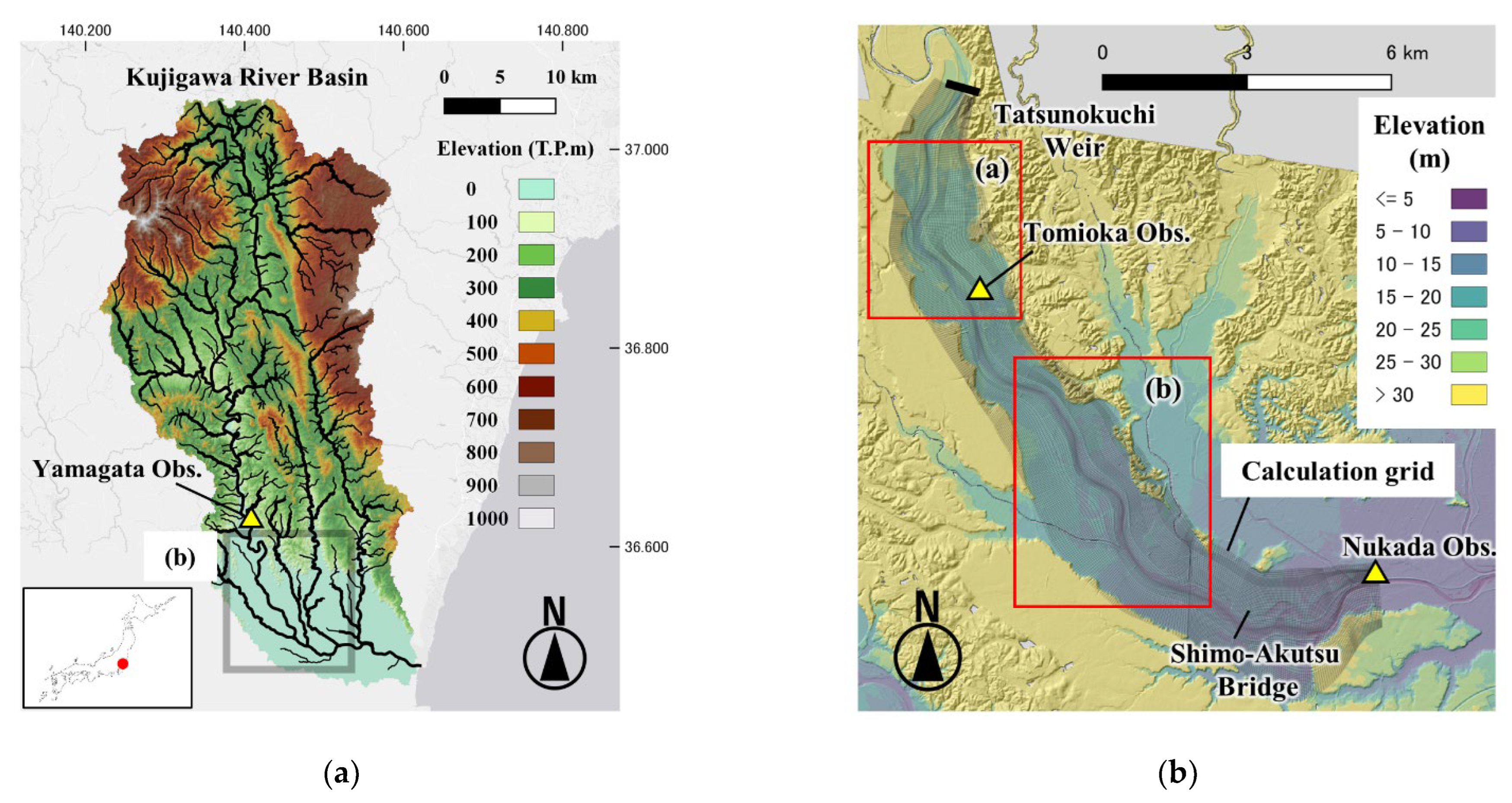
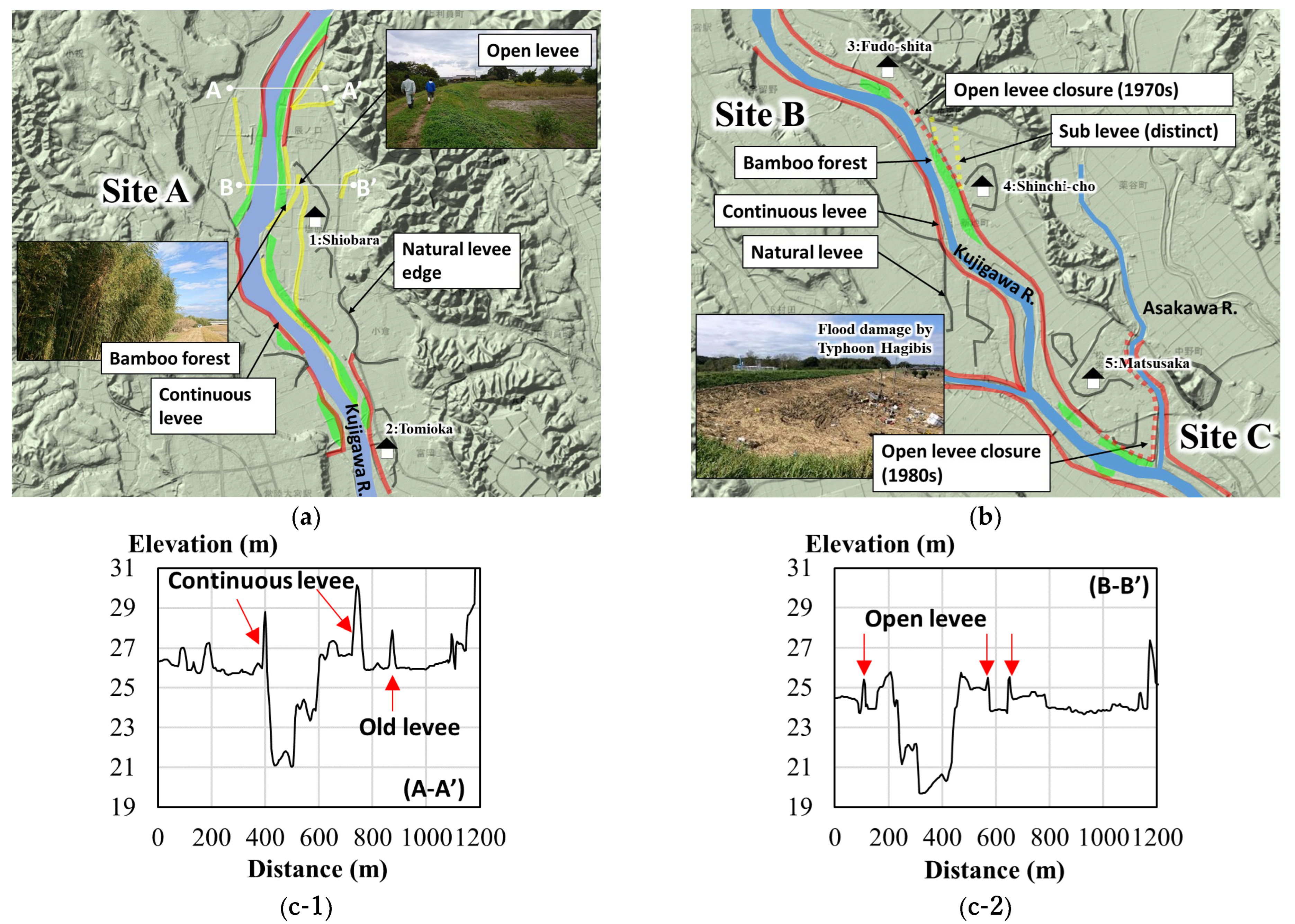
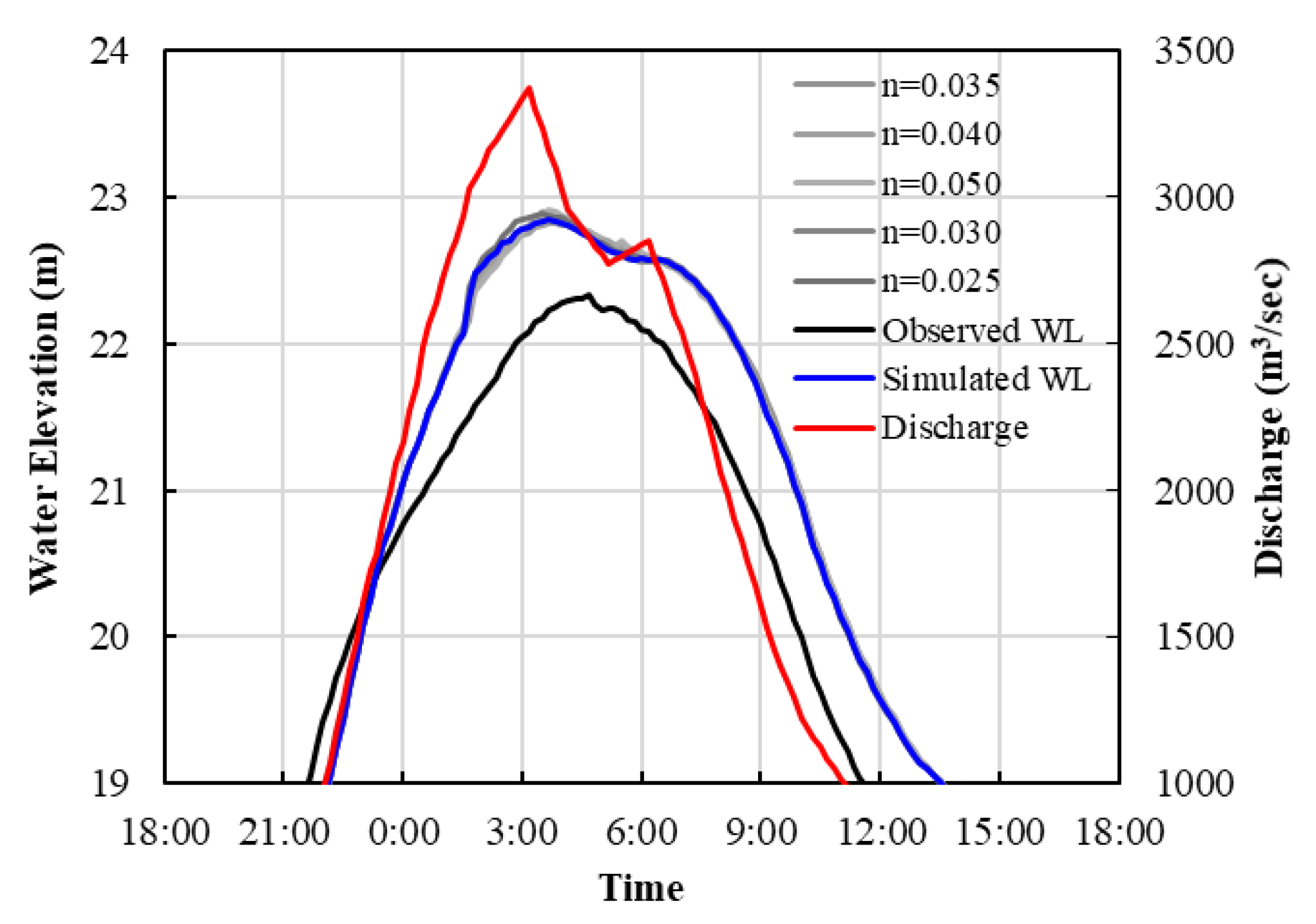
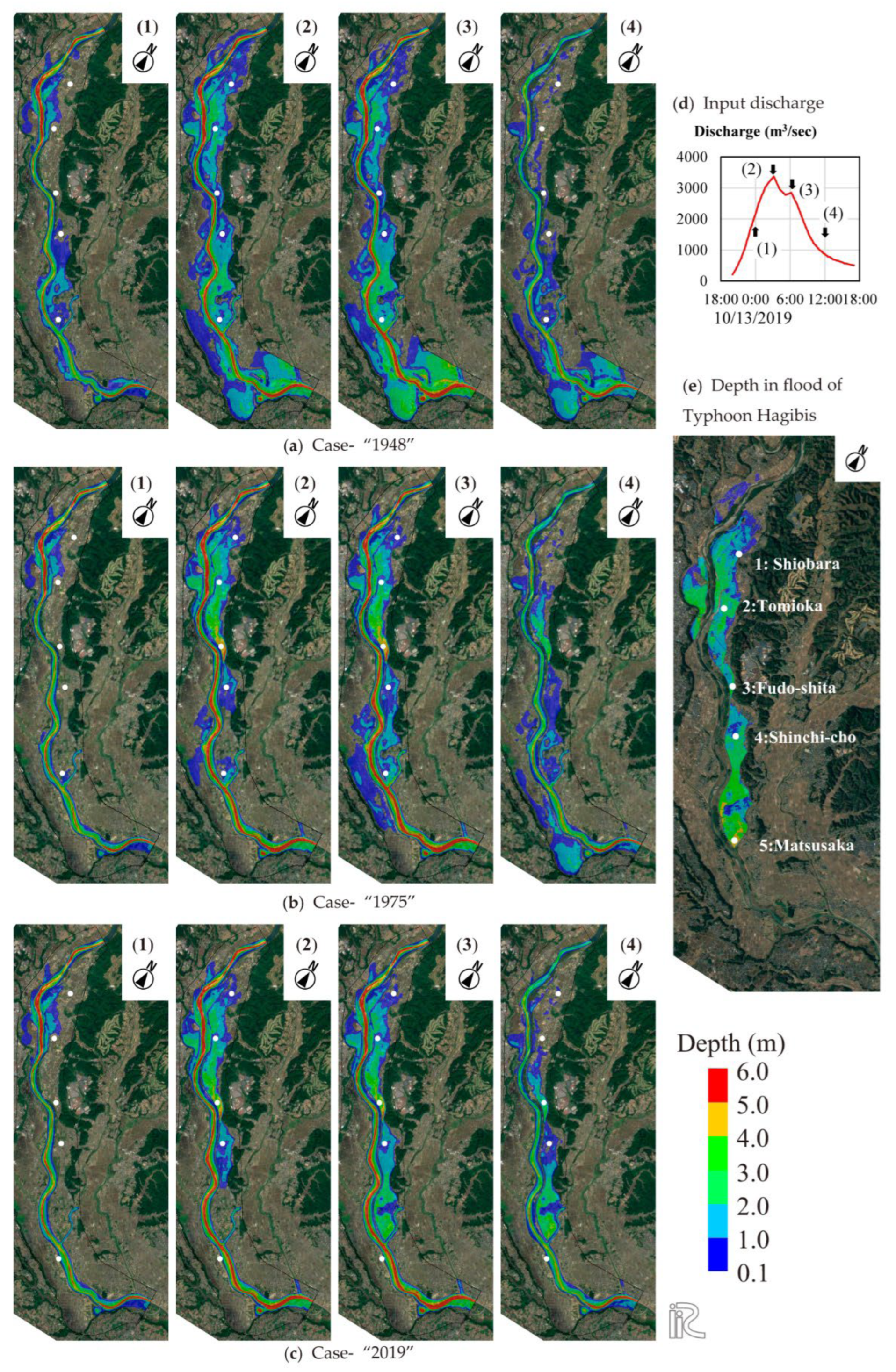




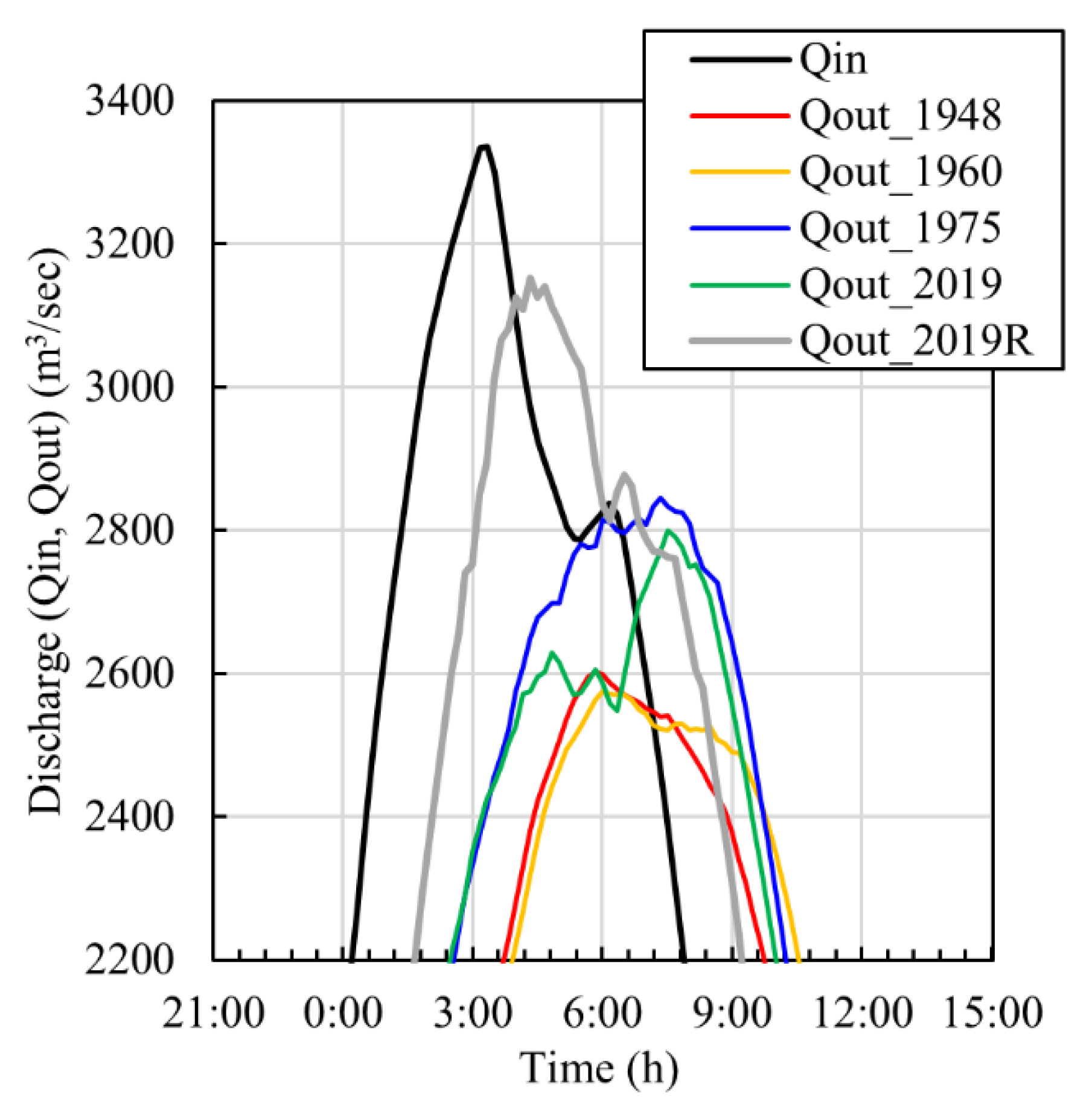
| Case | Topographic Condition |
|---|---|
| Case-“2019” | Laser-based 5 m resolution DEM (GSI, 2016) overlayed 200 m interval cross-sectional survey data (MLIT, 2013) |
| Case-“1975” | “2019” data eliminated in area where levees unbuilt in 1975 |
| Case-“1960” | “2019” data eliminated in area where levees unbuilt in 1960 |
| Case-“1948” | “2019” data eliminated in area where levees unbuilt in 1948 |
| Case-“2019R” | “2019” data extracted in river corridor |
| Case-“1960+” | “1960” data with sub levee |
| Case-“2019+” | “2019” data with sub levee |
| Manning’s n | Low-flow channel | 0.02 | 0.02 | 0.02 | 0.03 | 0.035 | 0.04 | 0.05 |
| (m−1/3s) | High-flow channel | 0.03 | 0.04 | 0.05 | 0.03 | 0.035 | 0.04 | 0.05 |
| RMS of error of depth (m) , where : calculated depth, : observed depth, : suffix of meshes, : nunber of tested meshes. ) | 0.836 | 0.923 | 0.990 | 0.840 | 0.896 | 0.896 | 0.922 | |
| Correctness of dry/wet (%) , where : Area that correctly indicates inundation, : Area that correctly indicates no inundation, and : Area of tested floodplain.) | 93.3 | 91.0 | 85.8 | 92.9 | 86.0 | 86.0 | 83.4 | |
Publisher’s Note: MDPI stays neutral with regard to jurisdictional claims in published maps and institutional affiliations. |
© 2022 by the authors. Licensee MDPI, Basel, Switzerland. This article is an open access article distributed under the terms and conditions of the Creative Commons Attribution (CC BY) license (https://creativecommons.org/licenses/by/4.0/).
Share and Cite
Ohtsuki, K.; Itsukushima, R.; Sato, T. Feasibility of Traditional Open Levee System for River Flood Mitigation in Japan. Water 2022, 14, 1343. https://doi.org/10.3390/w14091343
Ohtsuki K, Itsukushima R, Sato T. Feasibility of Traditional Open Levee System for River Flood Mitigation in Japan. Water. 2022; 14(9):1343. https://doi.org/10.3390/w14091343
Chicago/Turabian StyleOhtsuki, Kazuaki, Rei Itsukushima, and Tatsuro Sato. 2022. "Feasibility of Traditional Open Levee System for River Flood Mitigation in Japan" Water 14, no. 9: 1343. https://doi.org/10.3390/w14091343
APA StyleOhtsuki, K., Itsukushima, R., & Sato, T. (2022). Feasibility of Traditional Open Levee System for River Flood Mitigation in Japan. Water, 14(9), 1343. https://doi.org/10.3390/w14091343






